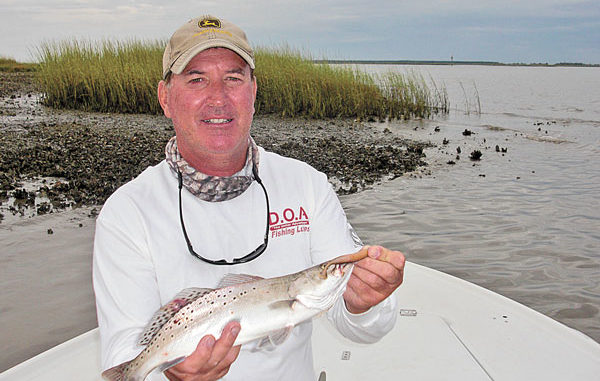
Capt. Reed Simmons of Charleston has seen plenty of tides ebb and flood during his 26 years as a fishing guide, and he has chased spotted seatrout up and down the Atlantic coast. His business card has an image of a D.O.A. Shrimp tied to a Cajun Thunder float, which represents his blueprint for fishing success.
“I’ve caught a ton of trout on the gold flake and the silver flake D.O.A. Shrimp,” said Simmons. (843-452-8844). “I rig them about 18 inches under my Cajun Thunder float and keep it popping pretty regularly to keep the trout bite going strong.”
It’s funny how sometimes the simple things can work the best, and that seems to be the case for Simmons. There is no telling how many tackle shops sell both items, allowing recreational anglers to obtain the same baits that he does.
Simmons runs out of Isle of Palms Marina in a 17-foot Action Craft, regularly heading up the ICW. He’s on the lookout during his runs.
“Look for spillways where the bait is streaming out of the estuaries as the tide falls,” said Simmons. “The shallows can be so clear in winter that you can see the fish in the water. Your job is then to locate the fish. Don’t get too close; just start out by watching what they are gonna do naturally.
“Approach them with care, using a push pole or a trolling motor, because if you can catch one trout without spooking the rest, then there is a good chance you can catch a bunch of trout from that same location.”
Spillways are places in the march where currents, waves, storms and what-have-you have washed shells up into and along the mouths of feeder creeks. As they wash away over time, they create spillways where the water spills out of the marsh, and the trout love to use them.
Simmons said the best locations for trout always have moving water, generally three to eight feet deep.
“Some shell banks along the marsh may look identical to the untrained eye,” said Simmons, “but depending on how the bait washes through an area, one location may consistently hold trout and another may not.”
As the water cools, the bait will linger in the shallows when the tide is up during the day because that water gets warmer as the sun warms the shells and the mud bottom. When the tide falls, the bait will have to flush out, and Simmons loves to fish the last two hours of the falling tide for that reason. The bait waits until late to leave the marsh, and the trout are onto that trick, just like fans know the No. 1 team in football is going to run the ball over and over again.
Simmons said that if the water gets real clear, it might not be necessary to pop the cork as much. The trout will hear it, and they can see it from further away, which may add up to a few more bites.
Structure to look for specs includes marsh points, sandbars — and they can be substantial, 100 yards wide — and shallow water or deep holes associated with creek mouths. In the shallow water, pole the boat along and make prospecting casts, being ready so a trout doesn’t surprise you and miss the hook.
Other baits that have been productive recently include the MirrOlure Mirrodine. D.O.A.’s CAL lures in Arkansas shad color work well fished under a float, and the D.O.A. BFL 5.5 bait has been ripped apart by plenty of gator trout looking for a larger meal.
Simmons also advises anglers to be ready for anything, which might come in the form of an inshore slam. Redfish can beat a trout to the lure sometimes, and flounder will rise up from the bottom to take a shrimp under a popping cork. All three species are feeding hard in the fall, and the blueprint for spotted seatrout just happens to have some crossover appeal.



Be the first to comment